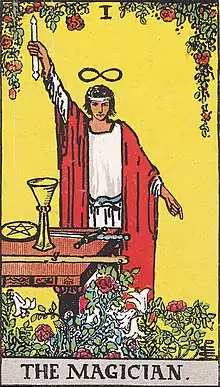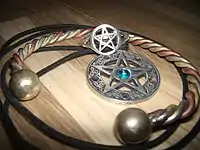Magical tools in Wicca
In the neopagan religion of Wicca, a range of magical tools are used in ritual practice.[1] Each of these tools has different uses and associations, and serve primarily to direct magical energies.[2] They are used at an altar, inside a magic circle.

In traditional Gardnerian magic, there was as an established idea of covens. This included initiated members that used rituals involving magical tools and secret books (Book of Shadows). These tools were predominately kept within a specific coven because they were so sacred. These were owned, and used by individual Wiccans, but could also be used collectively by the coven. However, there has been a tremendous shift in the way that the Wiccan religion is practiced today.
This practice may derive partly from Masonic traditions (such as the use of the Square and Compasses), from which Wicca draws some material,[3] and partly from the rituals of the Hermetic Order of the Golden Dawn. The latter made much use of material from medieval grimoires such as the Key of Solomon, which has many illustrations of magical tools and instructions for their preparation.[4]
Usage
In Wicca, ritual tools are used during rituals which both honour the deities and work magic. The general idea is that the tool directs psychic energies to perform a certain action.
In modern-day Wicca, there is an encouragement of solitary practice of rituals and study. Covens are still a part of Wicca and related doctrines but there is now insistence that solitary practice is permissible. This has filtered down to lightweight (in the sense of being heavily illustrated, not exactly scholarly and not entirely serious) books being available in the bookstores of any modern town which are marketed as manuals of how to become a Wiccan (or Pagan). The allowance of solitary practice is clearly an important factor in terms of the growth of adherents, as the requirement to join a coven would involve transaction costs of locating fellow members and/or being initiated.
In Gardnerian Wicca, as laid down by Gerald Gardner, someone who had been initiated in the 1st degree had to create (or, alternately purchase and then engrave) their own ritual tools. One of the requirements for being initiated for the 2nd degree is that the Wiccan had to name all of the ritual tools and explain what their purpose and associations were.[5]
Consecrating tools
Before tools are used in ritual, they first are consecrated. In the Gardnerian Book of Shadows, there is a section based entirely on consecrating ritual items.[6][7] In this, it states that items must be consecrated within a magic circle, at whose centre lies a paten. Each item that is to be consecrated is in turn placed upon the paten, sprinkled with salt and water, and then passed through some incense. This is followed by the declaration,
Aradia and Cernunnos, deign to bless and to consecrate this [tool], that it may obtain necessary virtue through thee for all acts of love and beauty. Aradia and Cernunnos, bless this instrument prepared in thine honour.[6][8]
The Primary tools
Various different tools are used in Wiccan ritual. Chief amongst them in importance are the paten, athame (or sword), wand, and chalice, each of which represents one of the four elements of earth, air, fire and water.
Pentacle or Paten
The Pentacle or Paten disc is an altar consecration tool with a sigil or magical symbol engraved or inscribed upon it. The most common symbol is a pentagram within a circle, specifically a pentacle, although some other symbols may be used such as the triquetra. The disc symbolizes the element earth. It is typically used to represent the element of Earth during evocation, as a symbol which blesses items, as well as magically energizing that which is placed upon it.[9][10][11]
Sword and knife
A sword or a ritual knife, commonly known as an athame, is often used in Wiccan ritual. In Gardnerian Wicca these are associated with the element of fire[5] and in Golden Dawn influenced traditions with air. This is only true, though, of the Dagger, which is painted with a yellow handle. The Sword itself is fire in that it is attributed to Geburah and is under the presidency of Mars. The Sword should not be confused with the Dagger in the Golden Dawn or Hermetic systems. The Dagger is Elemental in nature, the Sword is Planetary/Sephirotic in nature.[12]
The athame is traditionally black-handled, usually inscribed (sometimes in the Theban alphabet). It is used to direct energy for the casting of magic circles, controlling of spirits and other ritual purposes. Gerald Gardner described it as "the true Witch's weapon" in the Bricket Wood Book of Shadows,[13] something which he has been criticised for, by Frederic Lamond believing there should be no "weapons" in Wicca.[14] In some traditions, it is never under any circumstances used to draw blood, becoming tainted and requiring destruction if it does.[15]
The term "athame" in its modern spelling first appears in Wicca, but it originates from words found in two historical copies of the Key of Solomon. The version currently held in the Bibliothèque de l'Arsenal, Paris, uses the term "arthame" to describe a black-handled knife. This was adopted by C.J.S. Thompson in his 1927 book The Mysteries and Secrets of Magic and by Grillot de Givry, in his 1931 book Witchcraft, Magic and Alchemy. The historian Ronald Hutton theorised that Gardner got it either directly or indirectly from one of these sources, although with a modified spelling.[13]
Wand
In Gardnerian Wicca, the wand is symbolic for the element of Air, though in some traditions it instead symbolises Fire.[16] It can be made from any material, including wood, metal and rock, and Wiccan wands are sometimes set with gemstones or crystals.[10] Though in the Golden Dawn system, the Elemental Wand of Fire is not the same as other sticks (such as the Lotus Wand, Caduceus, or the staff of the Kerux).[17] Some traditions appear to confuse and conflate the various wands and staves into a single symbol.
In his Book of Shadows, Gerald Gardner stated that the wand is "used to summon certain spirits with whom it would not be meet to use the athame". Frederic Lamond states that this referred to elemental spirits, who were traditionally believed to be scared of iron and steel.[5]
Chalice
The chalice, or goblet, is symbolic for the element of Water. Many Wiccans do not consider it to be a tool, but instead to be a symbol of the Goddess, particularly her womb.[5] The chalice bears many similarities with the Holy Grail, except for its symbolism used in witchcraft. Rather than being the blood of Christ, it is symbolic of the Goddess' womb. The chalice is traditionally used to hold wine.
Other tools
Boline
The boline is a white handled knife, sometimes with a curved blade, like that of a crescent moon. It is used for more practical uses than the athame, for instance for harvesting and cutting herbs, inscribing candles with symbols or sigils, or cutting ritual cords. Unlike the athame, the boline is used in the physical process of magical works (such as ritual cutting); the boline serves for the physical plane what the athame serves for work in the spiritual/astral planes.
Scourge
The scourge, a type of religious whip, is used in Gardnerian Wicca to flagellate members of the coven, primarily in initiation rites. Frederic Lamond said that whilst Gardner never told his Bricket Wood coven which element this was associated with, he believed that as an "instrument for exercising power over others" then it should be Fire.[5] The scourge stands in contrast to "the Kiss" in Gardnerian and other forms of Wicca. These being representatives of the "gifts of the Goddess," the scourge standing for sacrifice and suffering one is willing to endure to learn, the kiss being the blessings of abundance in all life's aspects.
Cingulum
In the various forms of British Traditional Wicca, cords, known as cingulum, or singulum (which literally translates as "girdle" or "belt"), are worn about the waist by adherents. These are often given to a Wiccan upon their initiation, and worn at each subsequent ritual.[18] Traditionally they are nine feet in length (nine being three times three, the magical number), and are used to measure the circumference of the magic circle so that it can be set up correctly.[18]
In many traditions of Wicca, the colour of a person's cingulum indicates what rank of initiation they are; in several Australian covens for instance, green denotes a novice, white denotes an initiate of the first degree, blue for the second, and a plaited red, white and blue for the third, with the High Priest wearing a gold cingulum (symbolising the sun), and the High Priestess wearing silver (symbolising the moon).[18]
Wiccan High Priest Raymond Buckland has said that the cingulum should not be worn, but kept especially for spellcraft.
Besom
The besom, or broom, is often associated with witches and witchcraft. The stories of witches flying on brooms originated from the besom. In Wicca, it is used in handfasting ceremonies, when a couple jumps over it. It is also used in seasonal fertility dances as a representation of a phallus.
Cauldron
A cauldron is often associated with Witches and Witchcraft in western culture. In Wicca, it is sometimes used to represent the womb of the Goddess, like the chalice. It is often used for making brews (such as oils), incense-burning, and can be used to hold large, wide pillar candles, depending on how small it is. A fire is often lit within and the flames are leaped over as a simple fertility rite or at the end of a handfasting. If filled with water, a cauldron can be used for scrying. It plays a large role in Celtic magick, taking after Cerridwen's cauldron. Cerridwen was a Celtic goddess who possessed a cauldron that had a brew that took a year and a day to construct.
Jewelry

In various traditions of Wicca, jewellery depicting pentacles and other relevant symbols are sometimes worn, both in ritual, and as an everyday piece of jewellery.
Doreen Valiente, the Gardnerian High Priestess, claimed that when she was initiated into the craft by Gerald Gardner, she was naked, but accidentally left her necklace on, only to be told that it was traditional for witches to wear such things.[19]
In traditional forms of Wicca a necklace is worn by all women within a circle, representing the Circle of Rebirth.
Spear
In the tradition of Seax-Wica, the spear is used as a ritual tool as it is symbolic of the god Woden, who, in that tradition, is viewed as an emanation of God in place of the Horned God. According to Norse mythology, the god Odin, who is the Norse equivalent to the Anglo-Saxon Woden, carried the spear Gungnir. For the purpose of comparison it is important to note that Seax-Wica is not a part of traditional initiatory wicca, nor is it substantially linked to the Gardnerian or Alexandrian traditions.
Stang
The stang is usually a pronged wooden staff,[20] topped either with a naturally occurring fork or with antlers affixed.[21] The stang was among the ritual items used by Robert Cochrane,[22] while the term itself was likely popularized by his influence.[23] The Stang itself can act as a mobile altar for witches and can be used for representing the Horned God, directing energy, or helping with spirit journeying.[23]
Other
Ritual

There are elaborate rituals prescribed for the creation and consecration of magical tools.[24] These often include the ritual passing of the tool through representations of the four elements. Some tools are ascribed correspondences to a particular element, one commonly cited correspondence being:[25]
- Earth - Pentacle
- Fire - Wand
- Air - Sword
- Water - Chalice
These four tools may be seen in the occult tarot deck designed by Golden Dawn members A.E.Waite and Pamela Colman Smith, most obviously in the card known as The Magician. Some practitioners distinguish High Magic and Low Magic. The former is based on Ceremonial magic and may be more commonly practiced in Alexandrian covens. The latter is more typical of the Hedgewitch, who would be more likely to use everyday tools and utensils, rather than fabricating specially made magical tools.[26]
References
- Valiente, Doreen. Witchcraft for Tomorrow (1993) London: Robert Hale. ISBN 978-0-7090-5244-9 (paperback edition) ISBN 978-0-312-88452-9 (first hardback edition 1978). Chapter 6: Witch Tools (pp 78-85.)
- The Wicca Bible, Anne-Marie Gallagher
- Hutton, Ronald The Triumph of the Moon: A History of Modern Pagan Witchcraft (1999). Oxford: Oxford University Press. ISBN 0-19-285449-6 (pp52-61).
- MacGregor Mathers, S. Liddell (ed.) The Key of Solomon (Clavicula Salomonis) Revised by Peterson, Joseph H. (1999, 2004, 2005). Available here
- Lamond, Frederic (2004). Fifty Years of Wicca. Green Magic. pp. 125–126.
- "Gardnerian Book of Shadows: Consecrating Tools".
- Gardner, Gerald. The Gardnerian Book of Shadows. Forgotten Books. ISBN 978-1605069333.
- "Gardnerian Book of Shadows Index". www.sacred-texts.com. Retrieved 2020-12-07.
- Farrar, Janet; Farrar, Stewart (1984). The Witches' Way: Principles, Rituals and Beliefs of Modern Witchcraft. Phoenix Publishing. pp. 259–260. ISBN 978-0-919345-71-3.
- Gallagher, Anne-Marie (2005). The Wicca Bible. Godsfield. Page 201
- Wren (2000). The Tools of Witchcraft by Wren. Witchvox. Page 1
- Regardie, Israel (1990). The Complete Golden Dawn System of Magic vol. Four (Fourth ed.). Scottsdale, Arizona: New Falcon Publications (Falcon Press). p. 33. ISBN 978-0-941404-12-9.
- Hutton, Ronald (1999). Triumph of the Moon: A History of Modern Pagan Witchcraft. Oxford University Press. pp. 229–230.
- Lamond, Frederic (2004). Fifty Years of Wicca. Green Magic.
- Sabin, Thea (2010). Wicca for Beginners: Fundamentals of Philosophy & Practice. Llewellyn Worldwide. pp. 138–139. ISBN 9780738717753.
- Gallagher, Ann-Marie (2005). The Wicca Bible. Godsfield. Page 201
- Regardie, Israel (1990). The Complete Golden Dawn System of Magic vol. Four (Fourth ed.). Scottsdale, Arizona: New Falcon Publications (Falcon Press). pp. 35, 44. ISBN 978-0-941404-12-9.
- Cingulum, an article in Pentacle Magazine, issue 22, Autumn 2007, by an anonymous author
- The Rebirth of Witchcraft, Doreen Valiente
- The Witches' Stang
- Sarah Ann Lawless, How to Use a Stang
- Ronald Hutton, The Triumph of the Moon
- Kelden, The Stang
- Gardner, Gerald. Witchcraft and the Book of Shadows (2004) Edited by A. R. Naylor. Thame, Oxfordshire: I-H-O Books. ISBN 1-872189-52-0 (pp170-200)
- Crowley, Vivianne. Wicca: The Old Religion in the New Age (1989) London: The Aquarian Press. ISBN 0-85030-737-6
- Beth, Rae Hedge Witch: A Guide to Solitary Witchcraft, (1992) London: Robert Hale.
